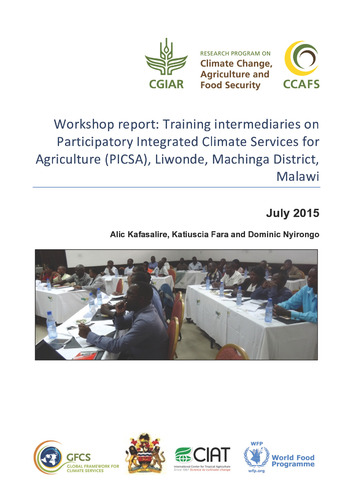Training intermediaries on Participatory Integrated Climate Services for Agriculture (PICSA), Liwonde, Machinga District, Malawi, 20-31 and 27-31 July 2015
Abstract
Two Training of Trainers (ToT) events were conducted at Hippo View Lodge in Liwonde, Machinga District, 20-24 and 27-31 July 2015. The purpose was to build the capacity of the intermediaries in Balaka, Nsanje and Lilongwe Districts in Malawi to apply the Participatory Integrated Climate Services for Agriculture (PICSA) to interpret and communicate climate service information with farmers. The PICSA approach aims to facilitate farmers to make informed decisions based on accurate, location specific climate and weather information; locally relevant crop, livestock and livelihood options; and participatory tools to aid decision making (Field Manual 2015). Seventy intermediaries from MoA, WFP, DCCMS, FRT, Malawi Red Cross and Concern Universal were trained in the two PICSA ToTs sessions. The training included resource allocation maps (RAM), seasonal calendars, calculation of probability planting dates using historical climate data (rainfall and temperature), cropping practices, livelihood and livestock options, and participatory budgets (PBs). The intermediaries had a one-day field practice where they facilitated the PICSA process with groups of farmers. During the field practice, intermediaries were able to successfully explain to farmers concepts related to climate variability and change and farmers were able to gain a better understanding on how the climate is changing. The participating farmers were able to calculate seasonal rainfall totals, probabilities associated with planting opportunities and season length; to identify different cropping practices, livelihood and livestock options; formulate participatory budgets; and factor this information into their season plans. Farmers and intermediaries found the field practice useful because they exchanged useful locally relevant climate information. It enabled DCCMS staff to gain a better understanding of farmers’ needs, and how to better translate and communicate difficult climate related concepts in a way that farmers could understand. They also encountered challenges, including difficulty understanding technical terms and interpreting historic climate date. Although the concept was challenging, the farmers grasped the methodology to calculate probabilities associated with information such as seasonal rainfall totals by end of the field practice.

